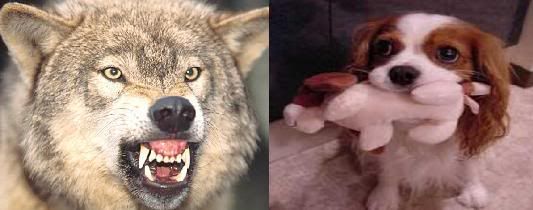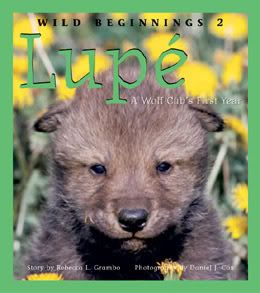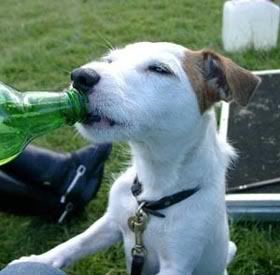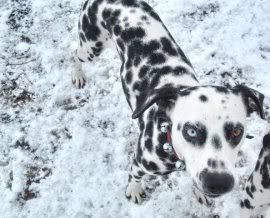
The evolution of dog and man has been reciprocal and intertwined. The first evidence of these canid beasts following and mingling with our hominid ancestors is 500,000 years old (Ostrander, et al., 2006). Dogs gave us an edge over other hominid species like the Neanderthal whose fossils do not show interaction with any canine species. Dogs may have played several important roles in aiding human survival, including providing early warning of intruders and assisting in the tracking of prey. It is speculated that the utilization of the superior scent capabilities of the dog by our ancestors left the olfactory system of early man free of scenting duties. Our nasal passages, no longer needed as much for smelling, could be shortened from muzzles to flat faces with rounded, fat tongues. This particular face shape allowed for greater variation in sound production, improving the speech capabilities of our ancestors. Therefore, our ability to communicate as well as we do verbally may, in part, be thanks to dogs and their contribution as trackers (Coren, 2000). This hypothesis may be a bit tenuous, but it is corroborated by the fact that Neanderthal and other primitive hominids dedicated more of their facial structure to the nasal passages.
140,000 year old fossil evidence reveals dog skeletons which display the morphological characteristics of breeding for domestication (Ostrander, et al., 2006). This is long before the first crops were sewn, before the first domestic horse was ridden, and well before the first cat snuggled in its master's lap. The first breedings were perhaps not fully intentional. The dogs which humans preferred received more food from a kill than the other dogs and were therefore more likely to survive. Dogs which attacked men or were aggressive were likely run off or killed. Friendliness toward man became a trait that better assured the selective survival and reproduction of these animals.
Much of the characteristic look of the domestic dog can be attributed to the selection processes of ancient man. The appearance of domestic dogs, including curled tails, splotchy coat patterns, shortened muzzles, floppy ears, and domed skulls, arouse well before dog fancying and appearance-based selection became popular. These looks came to be not so much because early man found them attractive, but because the look was linked to behavior.
Consider, for a moment, a wolf pup:

Its head is domed, its muzzle is short, and its ears are floppy at first. As the pup ages, the cell signaling and gene expression that brings the ears upright and elongates the muzzle and skull also bring about other adult characteristics like aggression and dominance. What better way for early man to control dogs than to select dogs which maintain puppy-like submission and amiability? This natural phenomena is called pedomorphosis, the retention of juvenile traits by adults (Trut, 1999). The puppy-ish look just happens to come with the temperament and behavior.
A famous Russian experiment in fox domestication demonstrates the link between morphology and domestication excellently. The experiment began over forty years ago with a wild colony of 130 foxes. Belyaev and a team of Russian scientist began to select foxes solely upon objective behavioral characteristics. They noted the changes in these foxes from generation to generation; both their morphology and temperament were recorded. After 30-35 generations of selection, the results were fascinating. The pups displayed a delayed development of the fear response as well was morphological characteristics more akin to domestic dogs such as skeletal differences, coat patters, curled tails, and some had floppy ears. Much of this may be linked to changes in plasma levels of corticosteroids, hormones concerned with an animal's adaptation to stress (Trut, 1999; WGBH, 2004).
As human civilization advanced dogs became useful in many lines of work. Novel breeds and varieties of dog were created to suit the changing needs of man. It is no surprise when a retriever, bred to retrieve shot ducks out of the lake, wants to take a dive in your pool, or when a sheltie, bred to herd sheep, is excitedly circling the children in the yard.
 It is not just the entertaining quarks of dogs which have been encouraged through breeding though, but some of the most irritating characteristics as well. Terriers, for example, are small dogs bred to hunt vermin. Some had the job of digging underground to find the rats or prairie dogs it hunted. The dog would often get stuck in the tunnel, and would bark vigorously to inform its master of its whereabouts and the location of the prey (Coren, 2000). The master would then dig up the dog and vermin. Although now considered irritating, the constant digging and excited barking of terriers was at one time considered useful and selected for.
It is not just the entertaining quarks of dogs which have been encouraged through breeding though, but some of the most irritating characteristics as well. Terriers, for example, are small dogs bred to hunt vermin. Some had the job of digging underground to find the rats or prairie dogs it hunted. The dog would often get stuck in the tunnel, and would bark vigorously to inform its master of its whereabouts and the location of the prey (Coren, 2000). The master would then dig up the dog and vermin. Although now considered irritating, the constant digging and excited barking of terriers was at one time considered useful and selected for. The genetics of dogs are as diverse as the tasks for which they were bred. Single nucleotide polymorphisms (SNPs) are the small genetic changes which account for much of the intraspecies variation we see in nature. We have sequenced nine breeds of dog so far and have found 2.6 million of these SNPs and counting! This incredible genetic diversity though is only seen between breeds. Within breeds, genetic erosion and the exposure of recessive alleles is a huge problem (Ostrander, et al., 2006).
Several factors make purebreds more susceptible to genetic disease. One is the founder effect—a few dogs often supply the genetic stock for entire populations, especially if the breed has been brought overseas. The most influential force acting to decrease the genetic diversity within breeds though is, undoubtedly, man. In an attempt to maintain breed purity and select for desired characterizes, people have often overlooked the genetic health of the animal. A certain desired quality may be linked to a disease allele due to its location on a chromosome, or it may be inseparable from the phenotype such as the breathing problems of bull dogs which are due to their characteristic look.
 As another example, in Dalmatians the instance of deafness is about 30% (50% in blue eyed phenotypes). There is a lower instance of deafness in Dalmatians showing splotchy ear patches due to the close linkage of the two traits on the dog chromosome, but because this characteristic is not seen as favorable in most kennel clubs, dogs displaying it are not selected for breeding. Even more alarming, all Dalmatians are homozygous recessive for a defective autosomal allele which affects purine metabolism leading to hyperuricosuria (causes kidney stones). This gene is tightly linked to the characteristic coat spotting pattern of the Dalmatians and so has not been eliminated.
As another example, in Dalmatians the instance of deafness is about 30% (50% in blue eyed phenotypes). There is a lower instance of deafness in Dalmatians showing splotchy ear patches due to the close linkage of the two traits on the dog chromosome, but because this characteristic is not seen as favorable in most kennel clubs, dogs displaying it are not selected for breeding. Even more alarming, all Dalmatians are homozygous recessive for a defective autosomal allele which affects purine metabolism leading to hyperuricosuria (causes kidney stones). This gene is tightly linked to the characteristic coat spotting pattern of the Dalmatians and so has not been eliminated.Even those who try to decrease the genetic erosion of purebreds face much opposition. In the 1970s, an independent breeder Dr. Robert Schaible made efforts to reduce homozygosity of the hyperuricosuria disease allele by breeding a pointer into his Dalmatian gene pool. Even the 5th generation 97% Dalmatian, 3% pointer pups are not accepted as purebreds by many kennel clubs and breeding associations, as the tight linkage of the genes still produces a coat that does not look "quite right."
Here are some other genetic disorders that are common to pure breds:
Breed
|
Genetic disorder
|
Irish Setter
|
Retinal atrophy
|
Vertebral degenerative joint disease
| |
Collies
|
Choroidal hypoplasia
|
Schnauzer
|
Cataract
|
 It is not just breeders and kennel clubs that create problems for dogs though. People often select their new family puppy based upon an appearance that they find appealing. I've been working at the local shelter for a while now and the most common breeds I see coming in are Labrador, husky, pit bull, and border collie mixes. It is likely that the former owners of these dogs took them home without researching the breed first. They might have purchased a husky imagining the rugged appearance it would give them, only to later realize that the dog requires a rugged lifestyle as well and does not find channel surfing an adequate exercise. Maybe they thought border collies were cute and trim but didn't understand that this energetic, intelligent breed often requires a lot of space and a job otherwise it may find other ways to occupy its active mind and body--such as tearing the couch to shreds. Others may have purchased what they hoped would be a fearsome guard dog pit bull only to realize they didn't have time to train it properly.
It is not just breeders and kennel clubs that create problems for dogs though. People often select their new family puppy based upon an appearance that they find appealing. I've been working at the local shelter for a while now and the most common breeds I see coming in are Labrador, husky, pit bull, and border collie mixes. It is likely that the former owners of these dogs took them home without researching the breed first. They might have purchased a husky imagining the rugged appearance it would give them, only to later realize that the dog requires a rugged lifestyle as well and does not find channel surfing an adequate exercise. Maybe they thought border collies were cute and trim but didn't understand that this energetic, intelligent breed often requires a lot of space and a job otherwise it may find other ways to occupy its active mind and body--such as tearing the couch to shreds. Others may have purchased what they hoped would be a fearsome guard dog pit bull only to realize they didn't have time to train it properly.The roles of dogs have changed, yet our attitude about breeds has not followed. Someday, maybe an unusually clever dog breeder will realize that what we really need is the ultimate couch potato dog, a breed that enjoys TV and snacks and the occasional game of fetch, rather than one bred for hunting, herding, or looks. Until then though, it is likely that dogs will continue to pour into our already crowded shelters. So do a dog a favor and research before you buy. Understand that every dog requires daily exercise, time, and dedication.

Sources:
Ostrander, E., Giger, U., Lindblad-Toh, K., and contributors (2006). The Dog and Its Genome. Cold Spring Harbor Laboratories Press. xvi, 31-53, 81, 200-212, 439-451
Trut, L.N. (1999). Early canid domestication: The farm-fox experiment. American Scientist, 87; 169
WGBH. (2004). Dogs and more dogs the true story of man's best friend. DVD. Boston, MA

